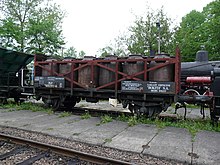Pot car
A tank wagon or acid transport car was a two-axle rail - freight wagons for the transport of acids and alkalis . It was used to transport acids such as sulfuric acid, oleum, hydrochloric acid, nitric acid, hydrofluoric acid and phosphoric acid.
construction
Since acids or alkalis can attack metals , they could not previously be transported in tank wagons , as there were no correspondingly resistant special alloys available for the containers. Instead, special wagons with earthenware pots were developed for transport. These wagons were manufactured in a riveted and later also in a welded design and can be found in Germany as early as 1911 on the Länderbahn freight cars . They were classified as “caution vehicles” because the earthenware pots were very sensitive to shunting bumps. In the upper area of the car body, these pots were attached to the wagon by a wooden or steel construction. Each pot had two connections, whereby compressed air was pumped through one of the connections and the liquid could escape at the other connection. One pot had a capacity of 800 to 1200 liters. 8 to 14 pots could be transported in one cart.
Special acceptance regulations applied to the construction of the "acid pot wagon":
- The floor of the wagon had to be made of tongue and groove wooden boards and painted with asphalt
- The floor of the car had to be inclined towards the long sides to allow any acid that had leaked out
- The drains had to be made of lead pipes that were long enough to prevent acid damage to vehicle parts (such as the braking systems)
- The pots were held at the bottom by pieces of tarred wood so that they could not move
- The joints between the pots and the frame were evened out by adjustable wooden blocks so that the pots could not move
- The end walls had to be higher than the earthenware pots so that the cargo could not spill over.
The disadvantage of acid pot trolleys is the fragility of the containers, so early attempts were made to replace them with metal containers. In addition to linings with rubber , which is resistant to many acids, experiments were soon made with materials that are attacked by acids, but form an oxidation layer which in turn is resistant to the acid. With the development of aluminum and finally stainless steel between the two world wars, acid pot carts with ceramic pots became obsolete. They remained in use until the 1980s because the new materials were too expensive or not sufficiently available. The last pot cars were used by the Deutsche Bundesbahn until the 1970s and by the Deutsche Reichsbahn until 1989/90.
Assignment
Despite their special design, pot cars belonged to the group of tank cars and were used by all European railway companies. At the Deutsche Reichsbahn they were used as "private cars" and belonged to private companies. They were assigned to the Reichsbahndirektion, in whose district the home station of the car was located. Private wagons were not given a class symbol , but only a wagon number, the name of a class district and the framed capital letter P. The Deutsche Bundesbahn also put pot cars on as private wagons; Capital letter P. At the Deutsche Reichsbahn in the GDR they were still in operation until 1990 and had the class symbol Z and class number 53.
Pot trolleys at the DRG
The pot car, built in 1928 for the Munich electrochemical plant, was set up as a private car by the Deutsche Reichsbahn-Gesellschaft (DRG) in the Munich Railway Directorate . It was manufactured in a riveted design and had a length over the buffers of 9,500 mm, its wheelbase was 4,500 mm, and the loading weight was 15 tons. It could hold twelve earthenware vessels and was only built with a brakeman's cab.
See also
- Association design freight cars - German freight cars from 1910
- Overview of freight car types up to 1945
Web links
Bibliography and sources
- H. Behrends; W. Hensel; G. Wiedau: freight cars of German railways . Alba Verlag, Düsseldorf 1989.
- Publishing group Bahn GmbH: MIBA booklets Nos. 10 and 11 , MIBA-Verlag, Nuremberg 2000.


